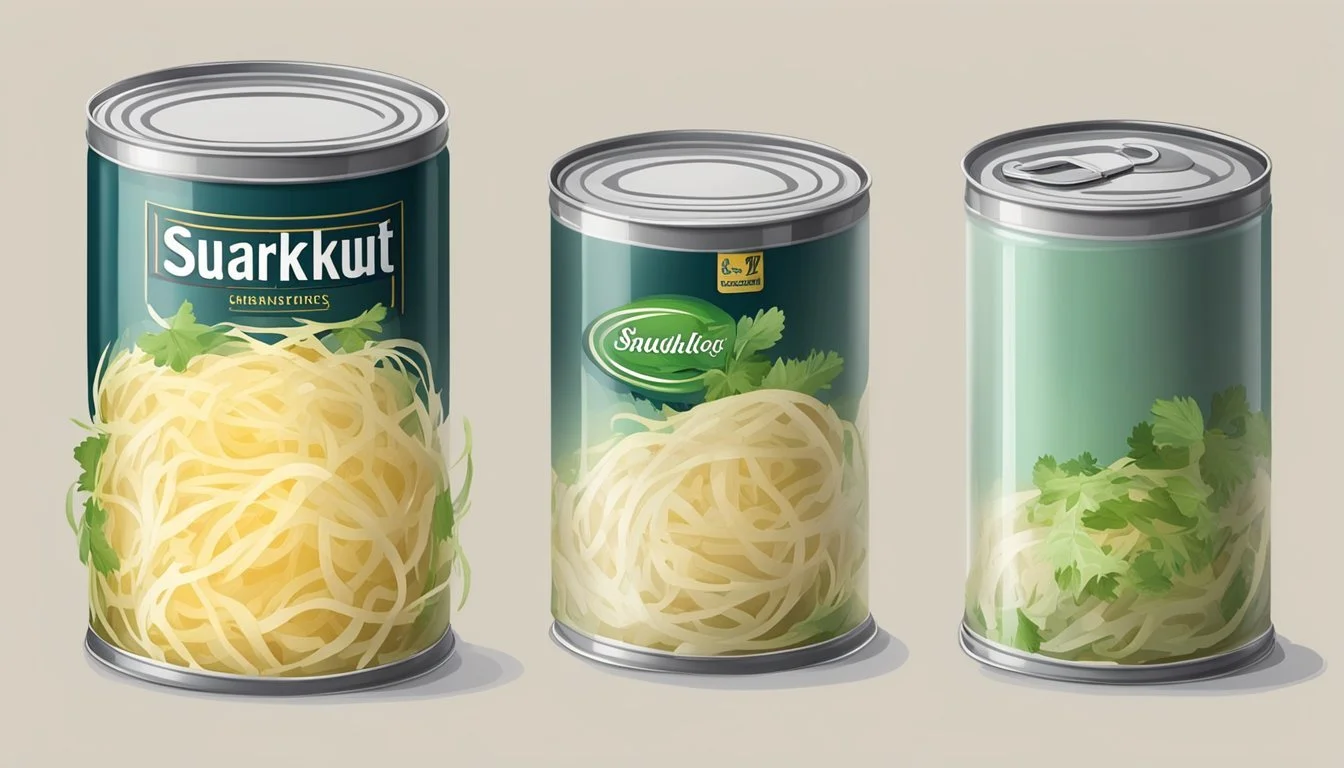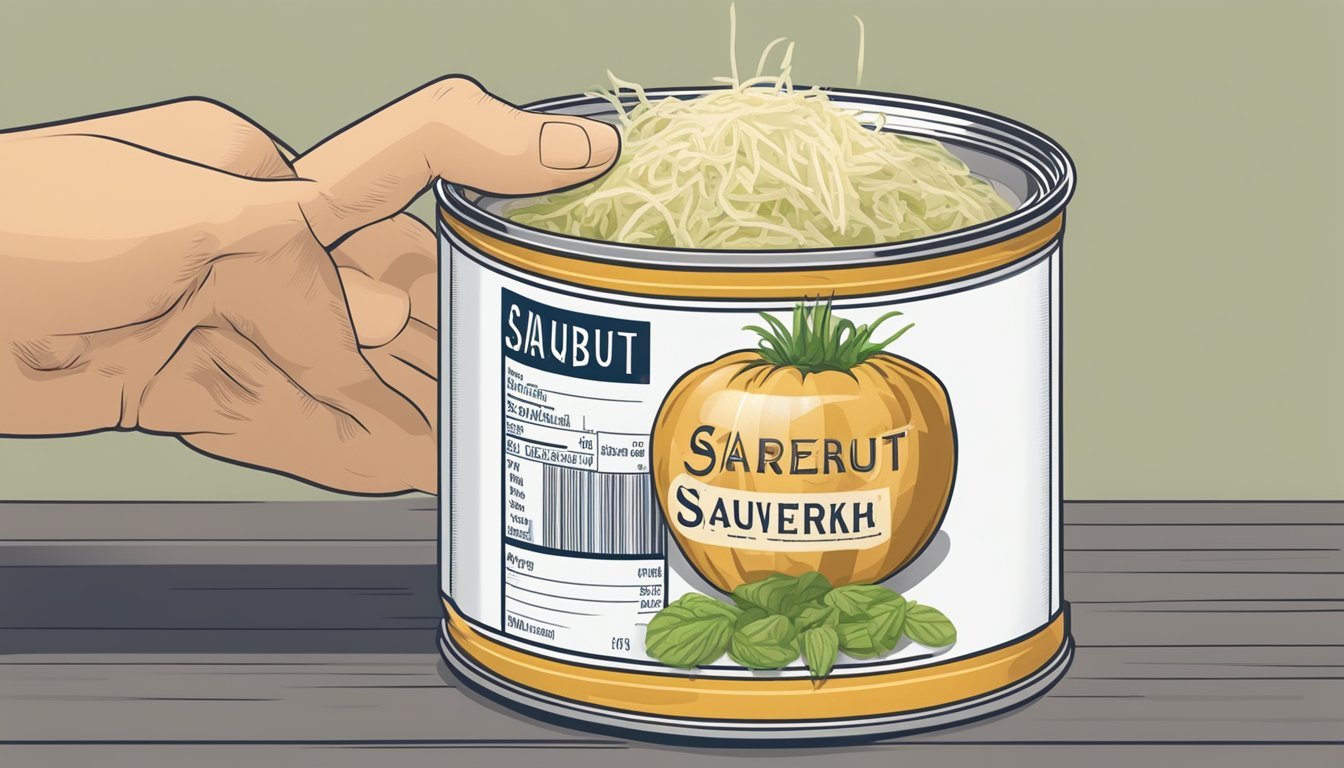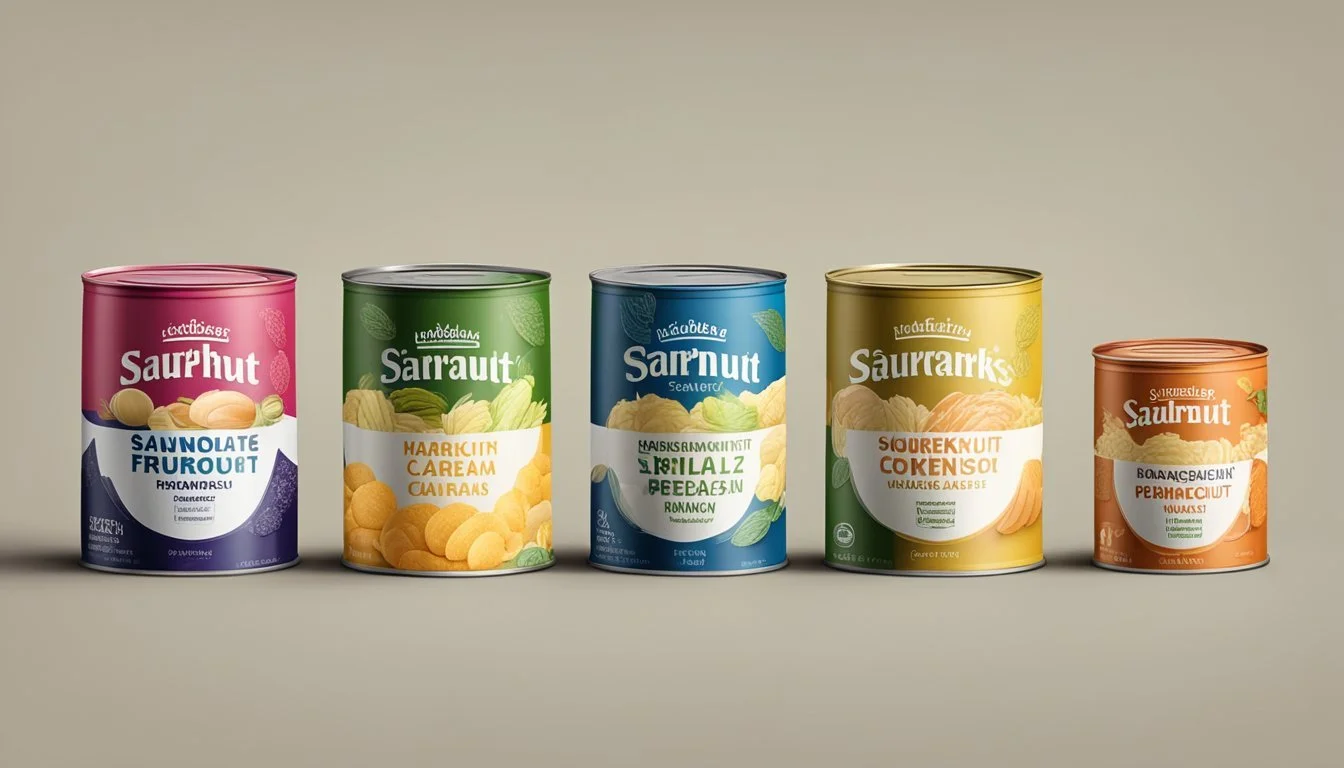Does Canned Sauerkraut Go Bad?
Important Shelf Life Information
Sauerkraut, a tangy and probiotic-rich fermented cabbage, is a pantry staple in many households. One might wonder if its canned variant can spoil over time. Yes, canned sauerkraut can go bad despite its long shelf life.
Canned sauerkraut can last for several months beyond its expiration date if stored properly in a cool, dry place. This extended shelf life is due to the fermentation process and the preservation provided by canning. However, signs like an off odor, unusual discolorations, or a bulging can are strong indicators that the sauerkraut should not be consumed.
To ensure the freshness and safety of your canned sauerkraut, always inspect the can for any damage and store it according to the guidelines. Consuming expired or improperly stored sauerkraut can pose health risks, so when in doubt, it's better to discard it.
Understanding Sauerkraut
Sauerkraut is a staple of many diets, made primarily from fermented cabbage. It is renowned for its probiotic content and can vary widely in terms of processing and pasteurization.
Fermentation Process
The production of sauerkraut begins with finely shredding cabbage and mixing it with salt. This mixture is left to ferment for several weeks. During fermentation, Lactobacillus bacteria convert sugars in the cabbage into lactic acid.
This acidic environment preserves the cabbage and inhibits the growth of harmful bacteria. The natural probiotics generated are beneficial for gut health. Unpasteurized sauerkraut retains these probiotics, while pasteurized variants may not.
Types of Sauerkraut
Sauerkraut can be found in various forms, each with distinct characteristics. Unpasteurized sauerkraut is raw; it contains live probiotics and must be refrigerated to maintain its beneficial properties.
Pasteurized sauerkraut is heat-treated, making it shelf-stable, but this process kills the probiotics. Consumers can buy sauerkraut from refrigerated sections, indicating it’s raw and probiotic-rich, or from non-refrigerated shelves, suggesting it has been pasteurized.
Shelf Life and Storage
Unopened canned sauerkraut can last for an extended period when stored correctly, while opened sauerkraut's shelf life varies significantly depending on storage methods. Proper conditions and techniques can maximize freshness and safety.
Optimal Storage Conditions
For unopened canned sauerkraut, a cool, dry place such as a pantry is ideal. Temperature stability is crucial. High temperatures can degrade quality, while excessive humidity may cause rust on the can. It is best to keep the sauerkraut in sealed containers to prevent contamination once opened.
Open sauerkraut should be refrigerated in an airtight container to avoid exposure to air, which can lead to spoilage. Storing it in glass jars may help preserve its flavor and texture. Always check the best-by date for guidance.
Pantry vs. Refrigerator
Unopened canned sauerkraut can be safely stored in the pantry for 3 to 5 years, though it remains safe to eat even afterward if the packaging is intact. Properly stored, it maintains peak quality within this period.
Once opened, transferring the sauerkraut to the refrigerator is mandatory. Refrigeration slows down the fermentation process, keeping it usable for several months if submerged in brine. In a pantry, opened sauerkraut deteriorates quickly, losing flavor and potentially developing harmful bacteria.
By adhering to these storage guidelines, the quality and safety of canned sauerkraut can be maintained effectively.
Signs of Spoilage
Detecting spoilage in canned sauerkraut involves examining visual cues, changes in texture and smell, and alterations in taste. Identifying these signs early can prevent foodborne illnesses and ensure the sauerkraut you consume is always fresh and safe.
Visual Indicators
Visual signs are one of the first indicators of spoilage. Mold growth is a significant red flag; it appears as fuzzy patches that can be white, green, or black. Discoloration is another indicator; fresh sauerkraut should maintain a pale, off-white color. Any darkening, yellowing, or development of unusual colors means the product may have gone bad. Look out for slime development on the surface; this slick, gelatinous layer often signals microbial activity, which is a clear indication of spoilage.
Texture and Smell
Texture changes in canned sauerkraut are typically noticeable. The sauerkraut should be crisp and firm to the touch. A soft or mushy texture implies that the sauerkraut is deteriorating. The smell is equally important; fresh sauerkraut has a tangy, sour aroma due to fermentation. If it emits a foul, off-putting odor, this is a strong indication that it has gone bad. Additionally, a presence of an ammonia-like or overly acidic smell means spoilage is likely.
Taste Alterations
Taste is the final and sometimes most telling indicator of spoilage. Canned sauerkraut should have a sharp, tangy flavor. If you notice a bitter, strange, or unusually mild taste, it could be a sign that the sauerkraut is no longer safe to consume. Any off-flavors or metallic aftertastes are significant signs that it has spoiled. Always avoid tasting sauerkraut that shows previous signs of visual or textural spoilage to prevent any health risks.
Health and Nutritional Information
Canned sauerkraut offers several health benefits, primarily due to its vitamin content and dietary fiber. However, it lacks live probiotics found in fresh or refrigerated sauerkraut, which impacts its effectiveness for digestive health.
Probiotics and Digestion
The canning process of sauerkraut involves heat treatment. This high temperature denatures all live bacteria and yeast cultures. Therefore, canned sauerkraut does not contain the probiotics that fresh or refrigerated sauerkraut provides. Probiotics are beneficial bacteria that aid in digestion and support the gut microbiome.
Without these probiotics, canned sauerkraut’s benefits for digestive health are limited. People seeking fermented food for digestive reasons should consider alternatives like refrigerated sauerkraut or other fermented vegetables that retain their live cultures.
Vitamins and Dietary Fiber
Canned sauerkraut is still a rich source of vitamins and dietary fiber. It is especially high in vitamin C and vitamin K. A single cup can contain about 21 mg of vitamin C and 19 mcg of vitamin K, which are essential for immune function and bone health respectively.
The dietary fiber in sauerkraut helps maintain digestive health. Fiber aids in the regularity of bowel movements and can help prevent constipation. Despite the lack of probiotics, the vitamin and fiber content makes canned sauerkraut a beneficial addition to a balanced diet.
Handling and Usage Tips
Proper handling and best practices are essential to ensure the freshness and safety of canned sauerkraut. This includes how to serve it and how to prepare it before consumption.
Serving Suggestions
Canned sauerkraut can be a versatile ingredient in the kitchen. It can be added to salads for a tangy crunch, served as a side dish, or used as a topping for sausages and hot dogs. For those who enjoy cooked dishes, sauerkraut pairs well with pork, becoming a staple in recipes like choucroute garnie.
Mix with kimchi for a fusion twist in Asian-inspired dishes. For a refreshing taste, serve it cold, straight from the can, or slightly warmed to enhance its flavor. Ensure it is submerged in brine to keep it moist and flavorful.
Preparation Guidelines
To prepare canned sauerkraut, first, open the can and drain the excess brine if desired. This step can help reduce its sharpness. If freezing, place sauerkraut in a freezer-safe container and label it with the date. Freezing may extend its shelf life up to 18 months but could alter its texture.
For refrigerator storage, transfer any leftovers into a properly sealed container to maintain freshness. Ensure the sauerkraut is submerged in brine to prevent it from drying out. When using sauerkraut in cooked dishes, add it toward the end of the cooking process to preserve its crunch.
Properly handling and storing canned sauerkraut can enhance its flavor and nutritional benefits, making it a valuable addition to various meals.
Safety Considerations
Canned Sauerkraut Storage: Proper storage is key to preventing food poisoning. Store canned sauerkraut in a cool, dry area to inhibit bacterial growth and contamination. High temperatures can compromise its safety.
Expiration Date: Always check the expiration date before consuming. Even if unopened, canned sauerkraut loses quality over time and can eventually spoil.
Signs of Spoilage:
Mold or Yeast Growth: Check for unusual discolorations, mold, or slimy textures, which can indicate contamination.
pH Levels: Proper acidity helps preserve sauerkraut. A high pH can lead to unsafe bacterial growth.
Unpleasant Smells: A sour, off-putting odor suggests spoilage.
Handling Opened Sauerkraut: Once opened, transfer the contents to an airtight container and refrigerate. This minimizes exposure to bacteria and yeasts.
Vinegar and Acidity: Vinegar is often added to increase acidity, making the environment hostile to harmful bacteria and molds. However, always inspect for any signs of spoilage regardless of added vinegar.
Potential Health Risks: Consuming spoiled sauerkraut can lead to food poisoning. Symptoms may include nausea, vomiting, and diarrhea. If in doubt, it is safer to discard the product.
Preserving Sauerkraut
Effective preservation methods can help maintain the quality of sauerkraut and extend its shelf life. This involves using proper canning techniques and methods to prolong its usability.
Canning Techniques
Canning is a reliable way to preserve sauerkraut and involves several crucial steps. Begin by sterilizing jars and lids to ensure a clean environment. After preparing the sauerkraut, pack it tightly into sterilized jars, leaving some headspace.
Next, pour a boiling brine solution over the sauerkraut, covering it completely. Seal the jars with sterilized lids and process them in a boiling water bath for the recommended time based on your altitude. This ensures that the sauerkraut is shelf-stable and can be stored in a pantry or kitchen cabinet away from direct sunlight or heat.
By sealing it properly, the sauerkraut remains preserved and safe to consume for an extended period.
Extending Shelf Life
Extending the shelf life of sauerkraut can be done through proper storage and handling. Keep canned sauerkraut in a cool, dark place, as exposure to light and heat can compromise its quality. Once opened, transfer sauerkraut to an airtight container and refrigerate it to prevent contamination and spoilage.
Freezing sauerkraut is another option to extend its shelf life, though it may affect the texture, making it softer. Homemade canned sauerkraut can be stored for months in sealed containers, ensuring it remains fresh. Always check for signs of spoilage, such as unpleasant smells or unusual discoloration, to ensure safe consumption. Proper techniques help preserve the flavor and safety of sauerkraut.
Comparing Sauerkraut Varieties
Different varieties of sauerkraut offer unique benefits based on their processing and packaging methods. Two main aspects to consider are pasteurization and the type of container used, such as jars or cans.
Pasteurized vs. Unpasteurized
Pasteurized sauerkraut undergoes heat treatment to kill bacteria, leading to a longer shelf life and stable flavor. This process, while ensuring safety, eliminates the live probiotics that are beneficial for gut health. Unpasteurized sauerkraut, often found in the refrigerated section, retains these live cultures, making it a popular choice for those seeking digestive benefits. However, it requires refrigeration and has a shorter shelf life. The differences in microbial activity impact not only the health benefits but also the texture and taste, which some consumers find more authentic in unpasteurized versions.
Jarred and Canned Variants
Canned sauerkraut is shelf-stable and typically has a longer shelf life due to the canning process's preservation techniques. It is convenient and easy to store but may contain additional preservatives. Jarred sauerkraut, particularly homemade sauerkraut and those available in specialty stores, often use natural fermentation without additives. Jars are reusable and sometimes preferred for environmental reasons. The choice between canned and jarred largely depends on personal preferences regarding preservatives, environmental impact, and desired flavor complexity. While jarred versions might be more artisanal, canned options offer unmatched convenience and storage flexibility.








